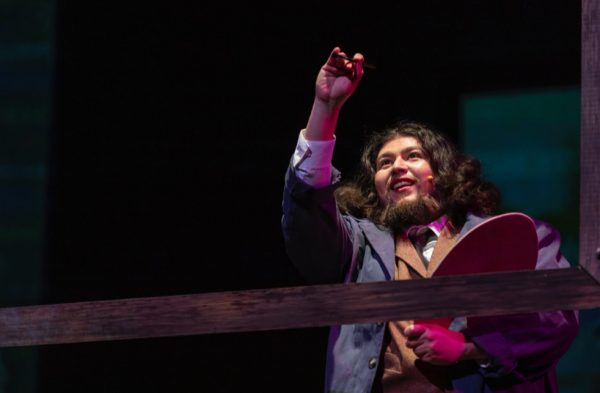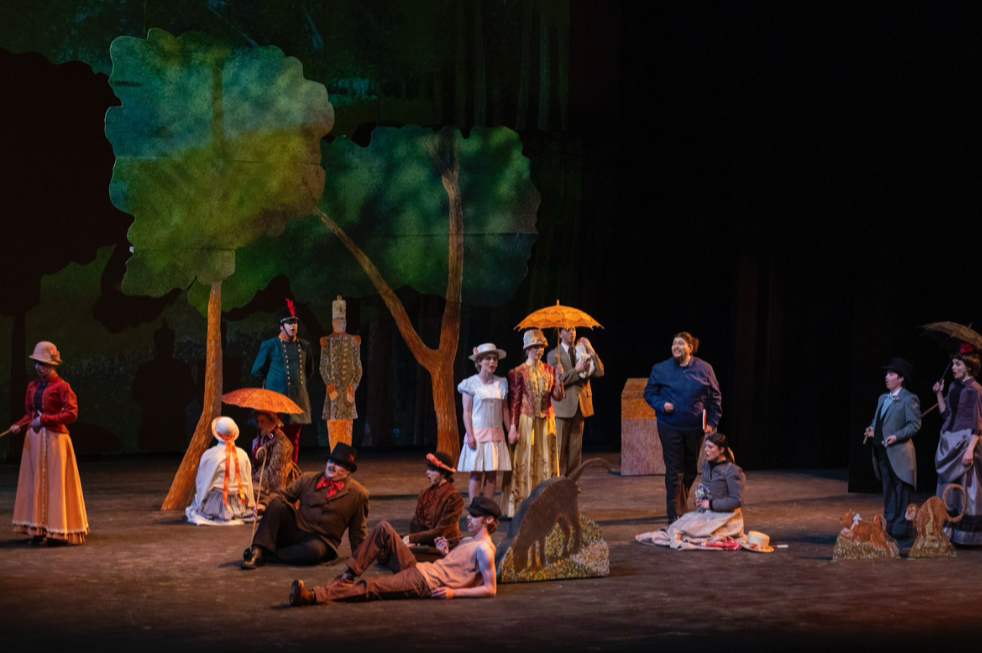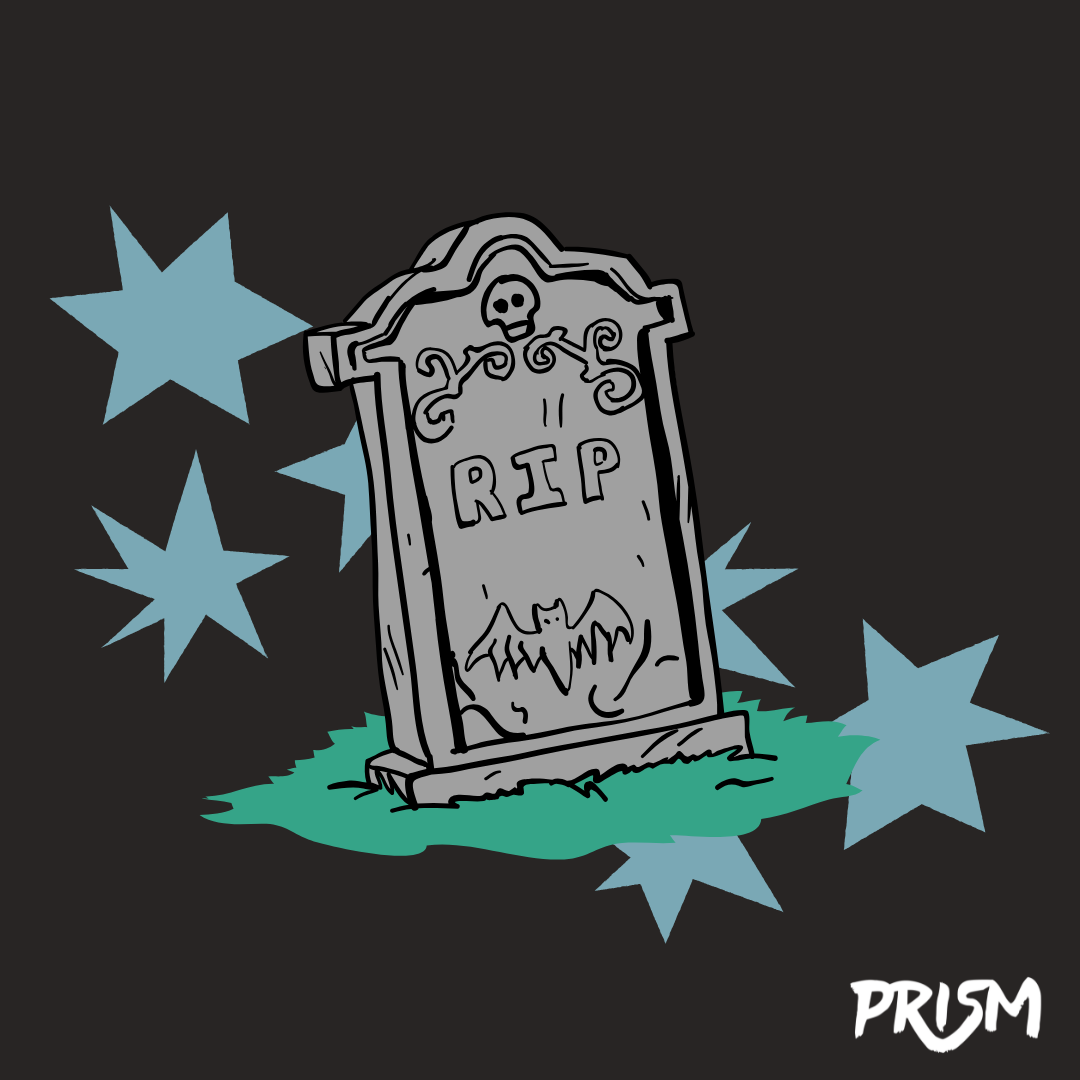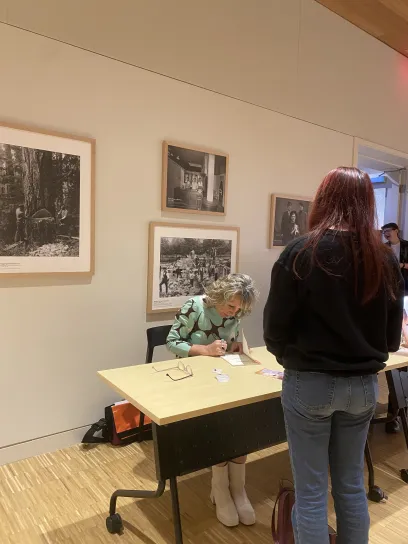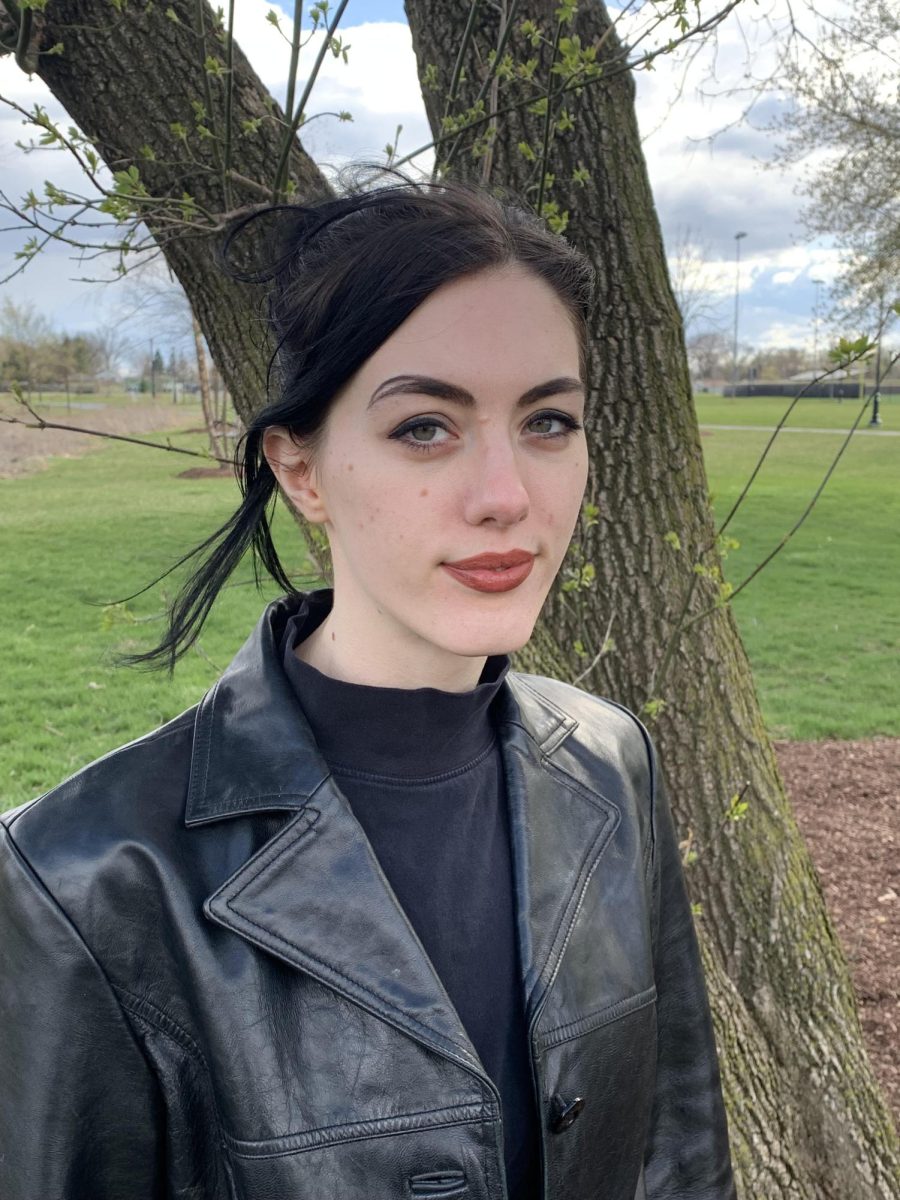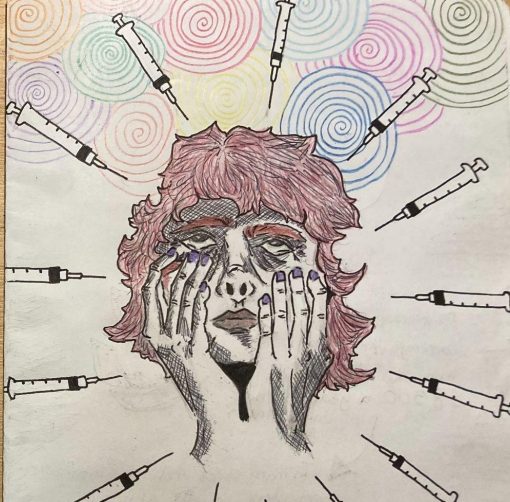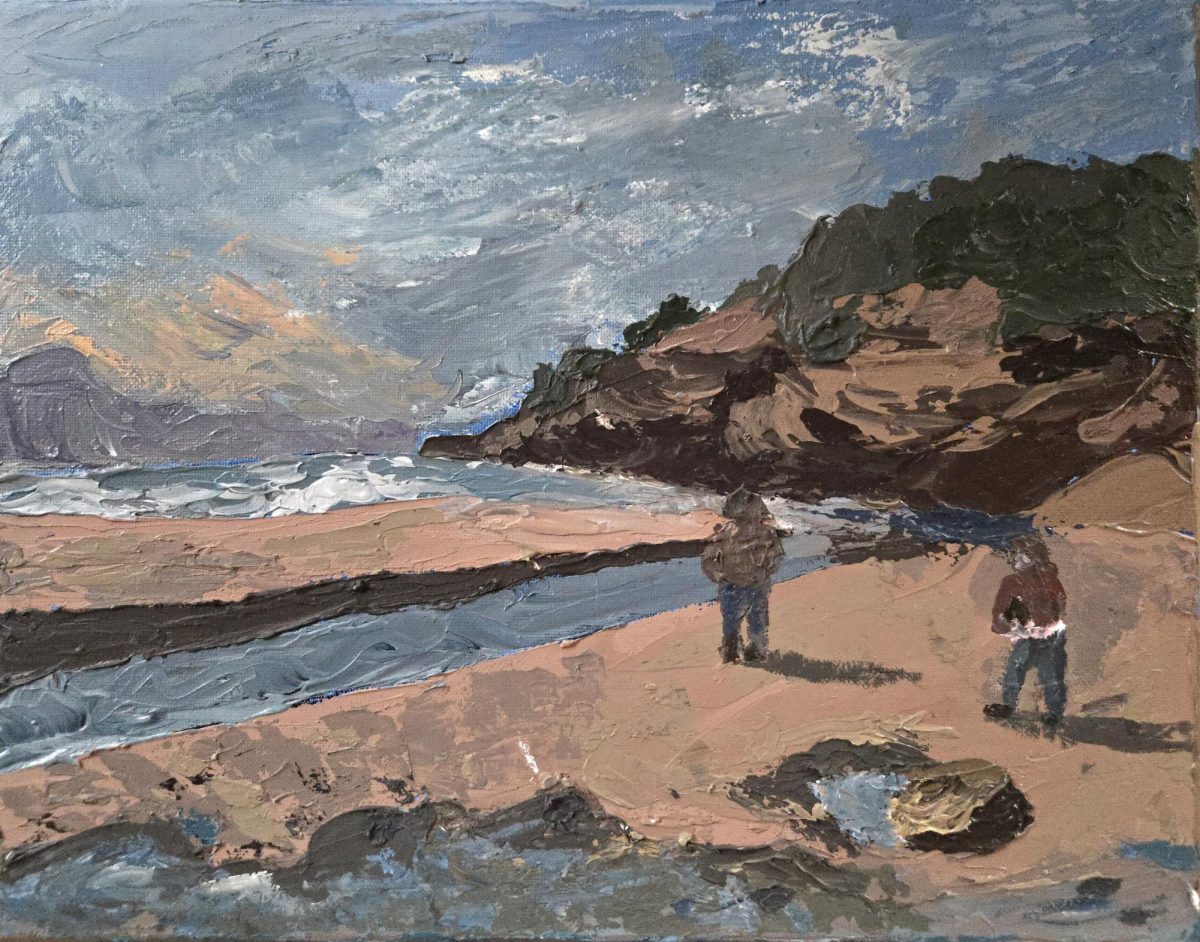For the Oregon State University Theatre and Music’s biggest annual spring performance of 2024, the Program put on Sunday in the Park with George, a 1983 musical by Steven Sondheim. This play centers Georges Seurat, an innovative French painter, as he works to create what would become his most famous work, the titular “A Sunday Afternoon on the Island of La Grande Jatte.” At two and a half hours long with two acts set a century apart, Sondheim’s musical explores the relationship between artist and muse, what it takes to truly change as a person, and the lasting impact of art in a world that seems to keep moving on.
As such, no character is more important in Sondheim’s story than Georges (and George) himself—played in the OSU production by Steven Evans-Renteria. As a music major, drama enthusiast, and long-time member of the theatrical and musical community here in Corvallis, Steven was ecstatic to talk with me about his experience as an artist and on the play itself.
***
Looking back now, because I think it has been almost a week exactly since the last show, on the dot, how do you feel about the production?
Good! I think it went really well. I really enjoyed working with everybody. This is probably the most, like, camaraderie I’ve felt in a cast. There’s been the least amount of drama. We all just wanted to get there. And I also think that one of the things about this show is that you don’t have time to do anything other than be-on-the-stage. Or, I guess at least in my case I’m on stage and then I’m on stage until the end. If I’m not on stage, I’m running to the other side to get on stage.
Could you speak a little more to the camaraderie?
Sure! Yeah. So, I’ve known Abigail Spear [Dot/Marie] since two or three years after getting to OSU in 2015. So we’ve known each other a long time, and this was kind of like rekindling our friendship again through theater stuff.
But not only Abigail, everybody in the cast. Even folks that I’ve never met before, people who were new to Oregon, people who were maybe new to this kind of scale of musical theater where it is so written out. It’s the hardest thing that I’ve ever done, and I’ve done things like operas and stuff, but this is the most challenging piece of art I’ve ever tried to tackle.
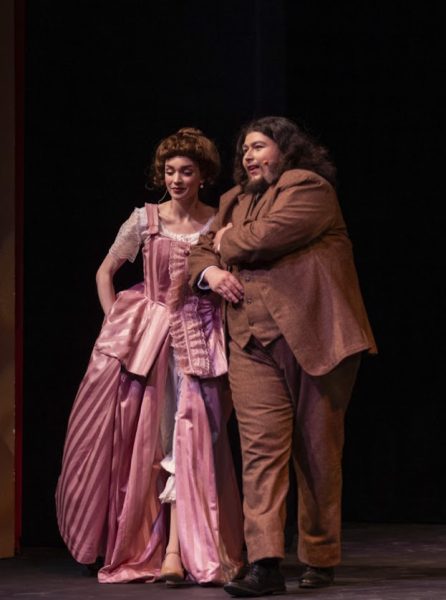
What was it like working with her? Saying she’s the emotional heart of the play is not entirely accurate, but in some ways she is.
Sure, yeah! I couldn’t ask for a better person to work with. I think that our own personal friendship made certain things really easy, and also that since we’re both like queer people we don’t have to worry about that chemistry getting too real. We know that we’re playing make-believe and it’s always make-believe and so we can get close to these places. And we both think about those characters in very similar ways. We found those people together. My George would not be the George that he was if it wasn’t for Abigail’s Dot being the way that they were.
The dynamic between you two was very convincing. How about for the director, Elizabeth Helman? Have you worked with her before?
I think we both did the math, and this is our 6th show together. So, yeah. We’ve done a lot of theater together, and it’s been a lot of fun, and anytime I get to work with Liz, I know that I’m going to be a part of something special. She doesn’t put on bad shows. That’s not a thing that she does. Whether she’s here at the university or over in Salem with Theatre 33 or down in Eugene with the Oregon Contemporary Theater, every production I’ve seen of hers, I’ve been affected in some way. Capital A-affected.
What are some changes or differences between your guys’ version of the production and others that have come before it?
That’s a really good question. I think the biggest difference between our version and the version that most people are familiar with is that we tried to find the humanity in George. With a little bit of shade to Mandy Patinkin. Apparently he’s not, like, fun to work with. His version of George comes off as very cold and unfeeling, which makes sense given that those are literally words that are said in the very first song of the musical, but it goes to almost the point of caricature where it doesn’t feel human. George has no redeeming qualities. And if George is irredeemable, then what’s the point of watching the show about the guy who’s really mean for two hours? It’s not fun in the sense that nothing about him becomes sympathetic if he’s just mean. So, we tried to find moments of humanity. That and also just the limitations of having to work in a borrowed space, right. It was a steep learning curve. Those are the two biggest things that stand out.
Based on that, and feeling out the humanity of Georges and George, how did you personally approach getting into his character?
So, this has been one of my favorite shows for a long, long time, and so I think I’ve always been thinking about what I can do with it, in a little way. I feel like any time you try to tackle a role that’s this big what you have to do a lot of—if you want it to come across as real and not like amateur-ish, for lack of a better word—is to just find those things that make the character human, make the character real. Inherently, musicals are going to be unrealistic. You have people singing out of nowhere.
Like the Georges dog number?
You have me rolling around and barking as two different dogs, two separate dogs. And then talking to paintings. There are these three very distinct manic episodes which happen throughout the show. How do you make those relatable to somebody’s mom who’s just out in the audience? Has never heard of Steven Sondheim or is very loosely familiar with Georges Seurat? So, finding people to bounce ideas off, just talking through what it is to be [Georges]. Who is this person, and what do they want, and what do they need, and what do they care about. Those are the places that you have to start from.
Who were these people for you?
A lot of time with Abigail, and then a lot of time with Liz. If we had a particularly good rehearsal, as a way to build esprit de corps, we’d get together over some fries and just talk about life. And sometimes life leads into the show and sometimes the show leads into life, but just, finding those analogs between the real and the imagined. What are the things that are similar? What are the things that are different? From your lived reality and the reality of the show.
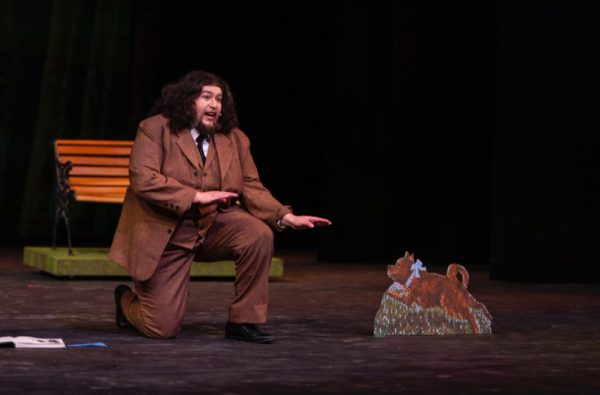
What was your favorite number to sing? Your least favorite to sing? And the hardest to sing?
My least favorite one to sing… I don’t know. I feel like it was different on different nights. They all have weird little idiosyncrasies that don’t mimic the way that any other songs I can think of or have done. Sure, they have little tunes and motifs that come back, but that’s just a consequence of making something that’s cohesive, that’s two hours long. You need to have some kind of shorthand that this means this, and this is the sound of going to the studio and stuff. So, I think that the hardest one to sing, by far, is “Putting it Together.” It is a song in 17 pieces, and every little chunk is broken up by dialogue. You have to remember dialogue, you need to remember blocking, you need to remember the words that are going on in the song, all at the same time. Sometimes the song goes into the dialogue goes into the song. Sometimes the song goes immediately into dialogue and then comes out in like two minutes and then you just have to start singing out of nowhere.
“Putting it Together” is, to be clear, at the end of the first act?
It’s the start of the second act. It’s the song after the chromolume presentation. With all the partygoers, I’m taking pictures with everybody, and I’m having a meltdown.
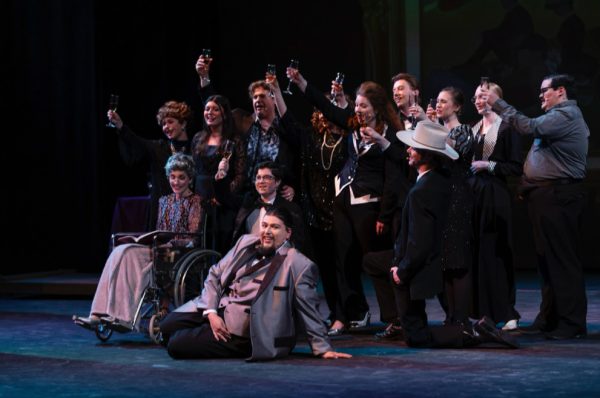
Still, I don’t know if I have a least favorite one to sing. The one that was most emotionally draining to sing is “Lesson #8” in Act 2, the “Charles has his book, Charles shows him his crayon, Marie has the ball with Charles, good for Marie.” It wasn’t until the first night when we opened that the lyrics made sense for me cause, you know, when you just sing it, you’re just practicing, and then when there’s people there things take on a different meaning. “George looks ahead, George sees the dark, George is afraid.” George the character might be doing that, in the moment, and seeing nobody or anything. But the actor playing George is literally staring out into an audience, where you can’t see people, you’ve got lights beating into your face, and you see darkness, and yeah, there’s always a tinge of fear. Is something going to go wrong?
That song was the most emotionally not-fun to sing. Some nights it was really rewarding to sing, other nights it was really draining. You get to the end of that song and, character-wise, you’re at rock bottom. You’ve gotten to do the thing that you thought you wanted to do and it hasn’t panned out the way you thought it would, and the island is smaller, and things are worse, and nobody is out doing the thing that you thought they would be doing. You spend your whole life thinking about doing this one thing, and you get there, and it’s different. Dealing with what that means; what do you do after that? And that’s the continuation, that’s the moving on.
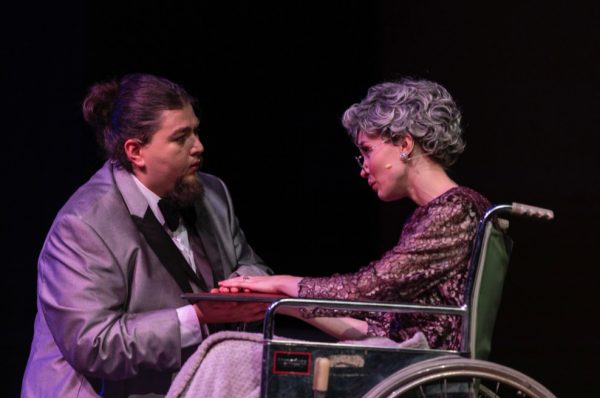
The most fun to sing is probably “The Day Off” or “Finishing the Hat.” “The Day Off” is the dog song, and “Finishing the Hat” is, like. That, I will say, wasn’t fun to sing because people don’t know what to do. You’ve just had a manic episode with a dog, you were just pretending to be a dog, which is weird, people don’t know what to do with that, and you come out of it and sing this ballad about the process of finding love and creating art and what does it mean to be human? I don’t know. There was never a night where I finished and I was like, “Yeah!” It was always like, “Oh, they have never understood.” The songs take on new meaning when you do them for people.
Yeah, that second act is a sprint.
Was it a sprint in the production side of things too?
Between Act 1 and the start of my section in Act 2 is the only section I get a break, and that’s 12 minutes intermission, and 10 minutes off-stage, so like 20 minutes, give or take. And after we sing the finale reprise, the big chord happens, everybody gets up off the stage, and I’m standing there. As soon as the lights come down, I run off one side, have to come all the way back around, come on the other. And we have to get there fast cause we’re doing curtain calls. Like a genuine sprint. It was a nice way to try to get out of my really big, happy ecstatic emotion, to be like just back in my body and run.
But also, pacing-wise and emotions-wise, it’s a sprint. You’re giving a lecture on Georges Seurat at the top of Act 2, and then you’re singing a song that has 17 parts, and then you’re having an emotional dialogue with your grandmother, and then you’re setting up a device on an island, and then you’re singing about how you’re afraid that you’re not going to exist anymore, you’re just going to be nothingness and a dot in a tapestry so to speak. And then your dead great-grandmother shows up, and you then see everybody in your great-grandfather’s painting, and then the show is over. It just goes, goes, goes, goes, goes, goes, goes. There’s no time to do anything, really. Act 2 is a sprint. Act 1 is longer than Act 2, but the pacing is different. There are moments of stillness. Whereas Act 2 just goes.
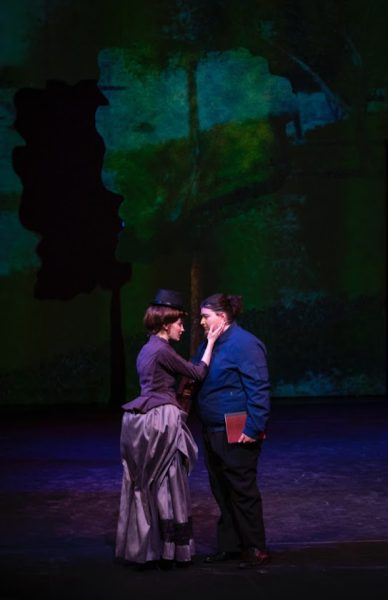
The play notably has a massive time jump between 1884 and 1984, the latter of which was the present time when the play came out in 1983. Now it’s almost 40 years later, on the dot. How do you think the change of the eras both in the context inside of the play and from when it was released to now affects how audiences see it?
I think that the way that we consume media and art in general is so tremendously different. The pandemic has changed, fundamentally, the way that we can view the world. The impetus for Sunday in the Park with George was that Steven Sondheim and James Lapine were at the Chicago Art Institute and they saw the painting and they said to each other, “Isn’t it weird that nobody’s looking at each other? There’s a bunch of different stories to be told with that?” And I think James Lapine said to Steven Sondheim that, “You know, the most important person is missing,” and that’s the painter, George Seurat. The rest is history.
It’s the way that we’re able to get art now. You had to be close to a museum, or be really close to a really good public library with decent books, or your school went on a field trip or some other way to consume art. But now, if you want to see a picture, you can take out your phone and see any picture in the world. Plus the creation and the digital art world that we live in.
I think that if Sondheim wrote it today, it would be very similar. I think that the differences would change in terms of the theatrical medium. Just, what is being used to say that this is the next evolution in art, this is the next step in art. It would probably just be digital media instead of it just being laser lights. And before it was laser lights, it was just avant garde performance art. The beauty of the show is that it can kind of live forever. The only thing that has to change is the medium. You can make it a period piece, you can set it in contemporary times, in terms of visual display and stuff. I’ve seen productions where it was all projection, I’ve seen productions where it was like gigantic screens were being used. What we did was some light projection, and mainly, physical props. You know, the soldier is a cardboard cutout, and the dogs are cardboard cutouts, and the monkey is a cardboard cutout, and one of the big dogs is just a dog on roller wheels.
And the little dog is in that big dog.
And the little dog is in the big dog. So, you know, art.
Alright, well, thank you very much for joining me. To finish, and you kind of got into this very, very early on, but what does this play mean for you as a career seeker in performance arts, and where do you think you’ll be going next?
What do you do after you’ve climbed Everest? No, that’s ridiculous. This is like a dream show, like I never, never thought I’d be able to have the opportunity to do this, so I’m just really grateful to Nick Larsen and Elizabeth Helmen and to the scenic designer, Steen Mitchell, and to Demara Cabrera, the costumer. I’ve done shows where you just bring clothes that you have at home and you just make a costume, and those are fine and those are fun, but there’s something about feeling it, feeling the same heat in the ridiculous, “I’m wearing a full 3 piece wool suit and it’s 80 degrees in hear and I’ve got blinding lights on me.” There’s something about living in that world. I mean, we worked on it for two and a half months. That’s a long time, it’s very uncharacteristic of things we do at OSU. They’re normally done in six weeks, ten weeks, and it’s kind of an accelerated process.
But this has been like a dream come true. And now I think that the next thing is just to find the next big, big mountain to climb and to climb that. And there’s a lot of art.
